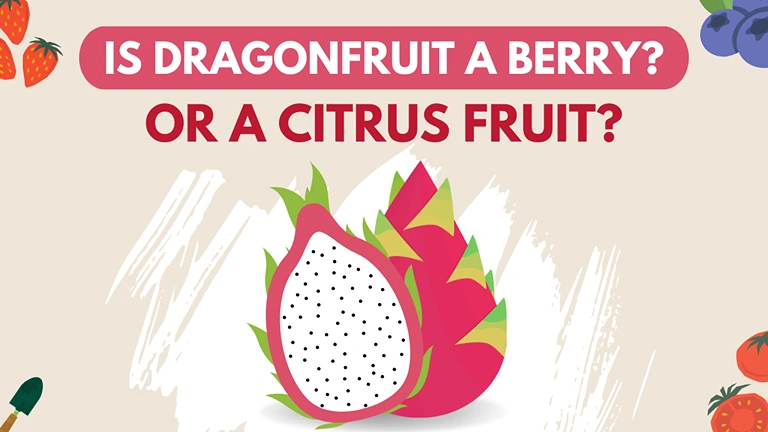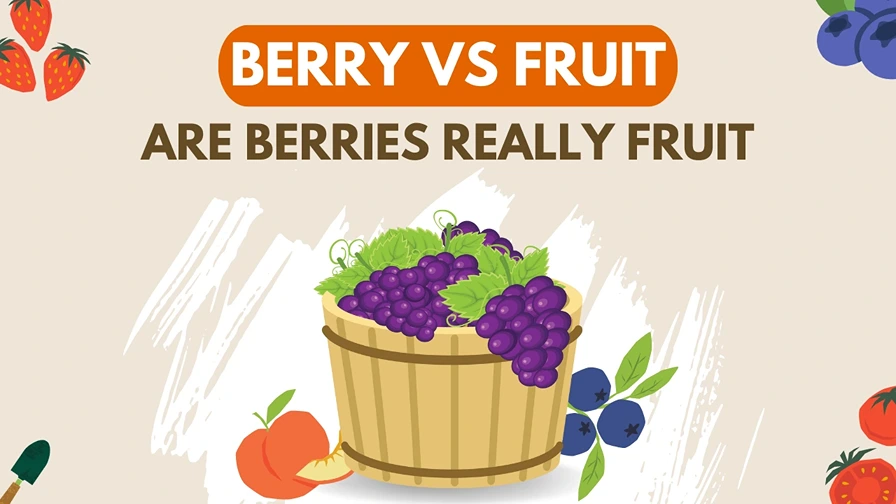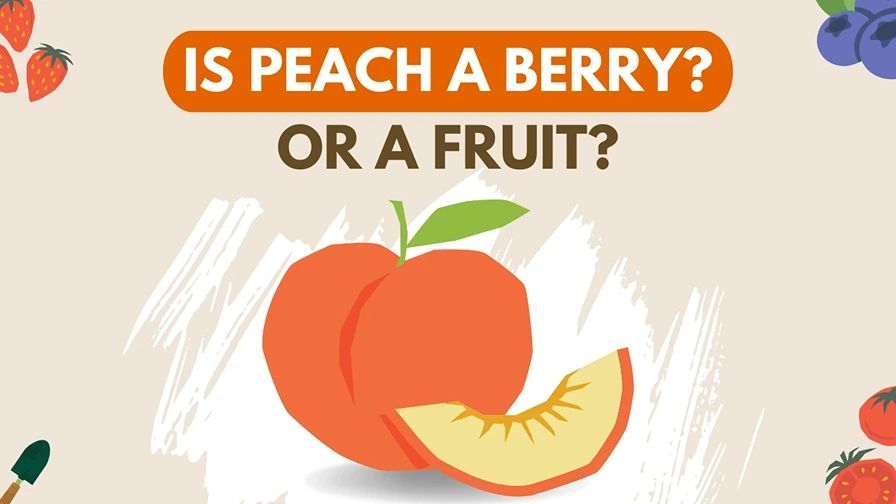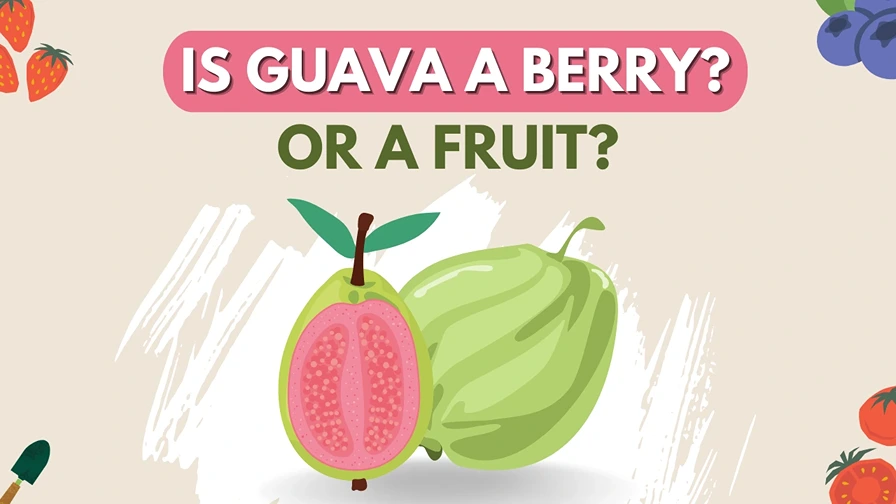Dragon fruit, with its vibrant colors and unique appearance, has captured the curiosity of many fruit enthusiasts. As you delve into the world of dragonfruit, you may find yourself stumbling upon a heated debate: Is dragonfruit a berry or a citrus fruit?
Yes, dragon fruit is a berry. In botanical terms, dragonfruit is classified as a berry fruit.
But why dragon fruit is classified as a berry and why it is not considered a citrus fruit?
Let’s embark on a journey of this berry vs fruit debate and unravel the mystery surrounding the classification of dragonfruit.

What is Dragon Fruit?
Dragonfruit, also known as pitaya, is a tropical fruit that traces its origins to several species of cacti primarily the Hylocereus and Selenicereus species. Native to Central America, particularly Mexico and parts of South America, dragonfruit has a rich history that dates back centuries.
It was cultivated and consumed by indigenous communities long before its introduction to other parts of the world. Over time, dragonfruit’s popularity spread to other regions, including Southeast Asia and various Pacific islands. Its health benefits and nutrients made it popular very quickly.
Physical Appearance and Structure of Dragonfruit
Dragonfruit’s striking appearance sets it apart from many other fruits. Let’s explore its physical characteristics:
- Exterior: Dragonfruit showcases a vibrant and eye-catching exterior, often adorned with shades of pink, red, yellow, or white. Its skin is typically covered in small scales, resembling the scales of a dragon—hence the name “dragonfruit.”
- Shape and Size: Dragonfruit comes in different shapes and sizes, although the most common varieties are oblong or oval-shaped. Some dragonfruit varieties have a length of about 6 to 7 inches, while others may be smaller or larger.
- Flesh: The outer skin of dragonfruit is thin and easily peelable. Once you cut into the fruit, you’ll find its intriguing flesh, which can range from white to pink or even red. The flesh is filled with tiny black seeds that are edible and add a delightful crunch.
There are different varieties of dragonfruit, each with its own unique characteristics and flavors. The most commonly found varieties are the white-fleshed and red-fleshed dragonfruit. The white-fleshed variety has a milder flavor, while the red-fleshed variety tends to be slightly sweeter.
Understanding Berries
When it comes to fruit classification, berries hold a special place. To determine whether dragonfruit falls under the category of berries, let’s first explore what defines these delightful fruits.
Definition of a Berry
A berry, in botanical terms, is a fleshy fruit that develops from a single ovary and has a pericarp layer to protect the fleshy pulp and multiple seeds.
Unlike other fruits, berries have a soft and juicy texture, making them a popular choice among fruit lovers. While berries come in various shapes, sizes, and colors, they all share common characteristics that distinguish them from other fruit types.
Typical Characteristics of Berries
Berries possess several typical traits that set them apart. Let’s take a closer look at these distinguishing features:
- Single Ovary: A berry fruit grows from a single ovary of a flower.
- Soft Pericarp: Berries have a soft and thin outer layer called the pericarp. This characteristic gives them their tender texture, making them enjoyable to bite into.
- Multiple Seeds: Berries contain multiple seeds embedded within the flesh. These seeds are often small and sometimes barely noticeable, as they blend seamlessly with the fruit’s juicy interior.
- Edible Skin: Unlike many other fruits, berries have an edible skin that adds to their overall taste and texture. The skin is typically thin, contributing to the berry’s juiciness and providing a burst of flavor.
So we have understood what is a berry. Now compare this classification with dragonfruit to determine is Dragonfruit really a berry or not.
Dragonfruit as a Berry
The debate surrounding dragonfruit’s classification often leads to speculation about whether it can be categorized as a berry. Let’s explore the characteristics that align dragonfruit with the berry family.
Similarities with Berries
Dragonfruit shares several traits with berries, which contribute to the argument for its classification as a berry. Let’s examine these overlapping characteristics:
- Single Ovary: Similar to berries, Dragonfruit also grows from a single ovary of a flower.
- Fleshy Fruit: Dragonfruit, like berries, is a fleshy fruit. Its soft and juicy flesh is a defining feature that aligns with the typical texture of berries.
- Multiple Seeds: Dragonfruit contains numerous tiny seeds embedded within its flesh. This characteristic is common among many berries, where the seeds are dispersed throughout the fruit’s juicy interior.
- Edible Skin: Similar to some berries, dragonfruit has edible skin. The thin outer layer adds to the overall taste and texture of the fruit, providing a pleasant contrast to the juicy flesh.
Size and Shape Considerations
While dragonfruit possesses some traits similar to berries, it deviates in terms of size and shape. Most berries are relatively small, while dragonfruit is larger and often elongated or oval-shaped.
This distinction raises questions regarding whether dragonfruit fits the typical size and shape profile associated with berries.
However, it is important to note that the berry category encompasses a wide range of sizes and shapes from small berries like blueberries and grapes to bigger berries like tomato and eggplant.
The characteristics of dragonfruit such as its fleshy texture, multiple seeds, edible skin, and juiciness, provide clear evidence that dragonfruit is a berry. Although dragonfruit’s size and shape may differ from traditional berries, the wide range of sizes and shapes within the berry family allows for the inclusion of unique fruits like dragonfruit.
But there are other perspectives as well that say that dragonfruit should be classified as a citrus fruit.
So can dragonfruit be classified as citrus fruit? Let’s find out!
Understanding Citrus Fruit
Citrus fruits, including oranges, lemons, limes, and grapefruits, belong to a specific classification known as “hesperidium”. Understanding the classification of citrus fruit helps us appreciate their unique characteristics and shared traits.
The term “hesperidium” refers to a specific type of fruit structure found in citrus fruits. It is a specialized berry with a leathery, thick rind, called the exocarp.
Beneath the rind lies a spongy layer called the mesocarp, and within it, we find the juicy pulp filled with citrus segments. The segments, also known as carpels, are the individual juice-filled vesicles we enjoy when we bite into a citrus fruit.
The hesperidium structure of citrus fruits plays a role in their culinary uses and benefits. The thick rind helps protect the juicy pulp, preserving the fruit’s freshness and flavor. The segments contain juice and pulp, which are rich in vitamins, minerals, and other beneficial compounds.
Is Dragonfruit A Citrus Fruit?
Dragon fruit, with its vibrant appearance and unique flavor, often raises questions about its classification. Let’s explore the botanical and structural differences between dragonfruit and citrus fruit to determine whether dragonfruit falls into the category of citrus fruits.
Botanical Distinctions
When examining the botanical characteristics, we find notable differences between dragon fruit and citrus fruit. While both belong to the flowering plant family, their taxonomic classifications diverge:
- Family: Citrus fruits belong to the Rutaceae family, which includes plants like oranges, lemons, limes, and grapefruits. On the other hand, dragon fruit belongs to the Cactaceae family, the same family as cacti.
- Genus and Species: Citrus fruits belong to the Citrus genus, with species such as Citrus sinensis (orange) and Citrus limon (lemon). Dragon fruit, scientifically known as Hylocereus spp., comes from a different genus altogether.
Structural Variations
The structural differences between dragon fruit and citrus fruit further contribute to their classification disparities. Let’s explore these distinctions:
- Fruit Shape and Size: Citrus fruits typically have a rounded or oval shape, varying in size based on the specific variety. In contrast, dragon fruit features an elongated shape with a cylindrical or oblong appearance. It tends to be larger than most citrus fruits.
- Outer Skin: Citrus fruit is characterized by a thick, leathery rind that is typically easy to peel. In contrast, dragon fruit showcases a distinctive outer skin with scales or spikes, resembling the appearance of a dragon’s skin.
- Flesh and Segments: Citrus fruits contain juicy, segmented pulp enclosed within the fruit’s membranes. The segments are typically fleshy and edible. In dragon fruit, the flesh is also juicy but differs in texture and appearance. Dragon fruit’s pulp is often described as crunchy, similar to a kiwi, and it lacks the segmented structure of citrus fruits.
Considering the botanical and structural differences, it becomes evident that dragon fruit does not fall into the category of citrus fruits.
While citrus fruits share taxonomic similarities and possess specific structural features, dragon fruit diverges in its family, genus, and distinct structural characteristics.
Cultivation and Growing Conditions
Dragonfruit cultivation requires specific growing conditions to thrive. Let’s delve into the key aspects of growing dragonfruit:
- Climate: Dragonfruit thrives in tropical and subtropical climates. It requires warm temperatures and is sensitive to frost and extreme cold. The ideal temperature range for dragonfruit growth is between 65°F and85°F (18°C to 29°C). It is commonly cultivated in regions with a consistent temperature throughout the year, such as parts of Southeast Asia, Central, and South America, and certain regions in the United States.
- Sunlight: Dragonfruit plants require ample sunlight for optimal growth. They prefer full sun exposure, so it’s essential to plant them in a location that receives direct sunlight for a significant portion of the day.
- Soil: Well-draining soil is crucial for dragonfruit cultivation. The soil should have good water drainage properties to prevent waterlogging, as excessive moisture can lead to root rot. Dragonfruit plants thrive in slightly acidic to neutral soil conditions.
- Watering and Irrigation: While dragonfruit plants are resilient to drought conditions, they still require regular watering. It’s important to provide adequate moisture during the growing season, especially when the plants are establishing their roots. However, overwatering should be avoided to prevent waterlogged soil.
- Support and Trellising: Dragonfruit plants are climbers by nature, and they require support to grow upright. Trellises or stakes can be used to provide structural support to the plants as they develop. This allows the aerial roots to attach and climb, promoting proper growth and fruit production.
Culinary and Culinary Uses
Dragonfruit’s vibrant appearance and mild flavor make it a versatile ingredient in various culinary creations. Here are some popular culinary uses of dragonfruit:
- Fresh Consumption: Dragonfruit can be enjoyed as a standalone fruit. Its refreshing and mildly sweet taste, coupled with its crunchy texture, makes it a delightful snack.
- Smoothies and Juices: Dragonfruit’s vibrant color and mild flavor make it a popular addition to smoothies and juices. It adds a visually appealing element and imparts a subtle sweetness to the beverages.
- Salads and Salsas: Dragonfruit’s unique appearance makes it an excellent addition to salads and salsas. Its mild flavor complements other ingredients, adding both visual appeal and a refreshing touch.
- Desserts: Dragonfruit is often used as a decorative element in desserts such as cakes, tarts, and sorbets. It’s vibrant color and distinct shape make it an eye-catching addition to dessert presentations.
Dragonfruit’s versatility in the culinary world, coupled with its health benefits and exotic appeal, has made it increasingly popular among food enthusiasts worldwide.
Conclusion
In conclusion, based on its characteristics, dragonfruit is indeed classified as a berry.
The fruit grows from a single ovary of a flower similar to berries. It also possesses all the key attributes of a berry, such as a fleshy interior, numerous seeds embedded within the fruit, edible skin, and a vibrant, colorful appearance.
Although its external appearance might suggest otherwise, dragonfruit’s internal structure aligns with the botanical definition of a berry. Therefore, it is safe to say that dragonfruit falls within the category of berries and can be enjoyed as such.




